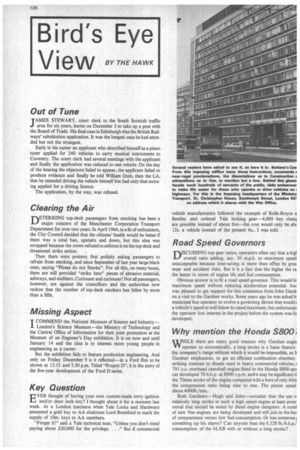Bird's Eye
Page 128

If you've noticed an error in this article please click here to report it so we can fix it.
ViewBY THE HAWK
Out of Tune
TAMES STEWART, court clerk to the South Scottish traffic J area for six years, leaves on December 5 to take up a post with the Board of Trade. His final case in Edinburgh Was the British Railways' substitution application. It was the longest case he had attended but not the strangest.
Early in his career an applicant who described himself as a piano tuner applied for 240 vehicles to carry musical instruments to Coventry. The court clerk had several meetings with the applicant and finally the application was reduced to one vehicle. On the day of the hearing the objectors failed to appear, the applicant failed to produce evidence and finally he told William Ouin, then the LA, that he intended driving the vehicle himself but had only that morn ing applied for a driving licence.
The application, by the way, was refused.
Clearing the Air
DETERRING top-deck passengers from smoking has been a major concern of the Manchester Corporation Transport Department for over two years. In April 1964, in a fit of enthusiasm, the City Council decided that the citizens' health would be better if there was a total ban, upstairs and down, but this idea was scrapped because the crews refused to enforce it on the top deck and
threatened strike action. , Then there were posters; first politely asking passengers to refrain from smoking, and since September of last year large black ones, saying "Please do not Smoke". For all this, on many buses, there are still provided "strike here" pieces of abrasive material, ashtrays, and stubbers. Curiouser and curiouser! Not all passengers, however, are against the councillors and the authorities now reckon that the number of top-deck smokers has fallen by more than a fifth.
Missing Aspect
T COMMEND the National Museum of Science and Industry' London's Science Museum—the Ministry of Technology and the Central Office of Information for their joint promotion at the Museum of an Engineer's Day exhibition. It is on now and until January 14 and the idea is to interest more young people in engineering as a career.
But the exhibition fails to feature production engineering. And only on Friday December 9 is it reflected—in a Ford film to be shown at 12.15 and 3.30 p.m. Titled "Project D", it is the story of the five-year development of the Ford D series.
Key Question
VER thought of having your own custom-made lorry ignition and/or door lock key? I thought about it for a moment last week. At a London luncheon when Yale Locks and Hardware presented a gold key to AA chairman Lord Brentford to mark the supply of 10m. keys to AA members.
"Forget it!" said a Yale technical man. "Unless you don't mind paying about £20,000 for the privilege. . . ." But if commercial vehicle manufacturers followed the example of Rolls-Royce a Bentley and ordered Yale locking gear-4,000 key chani are possible instead of about five—the cost would only be abc 12s. a vehicle instead of the present 6s., I was told.
Road Speed Governors
D[ SC USSING top-gear ratios, operators often say that a higl overall ratio adding, say, 10 m.p.h. to maximum speed unacceptable because time-saving is more than offset by grea wear and accident risks. But it is a fact that the higher the ra the better in terms of engine life and fuel consumption.
Obvious answer is to fit a road speed governor. This would lit maximum speed without reducing acceleration potential. Anc was pleased to get support for this contention from John Gardr on a visit to the Gardner works. Some years ago he was asked b: municipal bus operator to evolve a governing device that would ( a vehicle's speed to well below its rated maximum; but unfortunate the operator lost interest in the project before the system was fu developed.
Why mention the Honda S800;
ILE there are many good reasons why Gardner engin operate so economically, a long stroke is a basic feature the company's range without which it would be impossible, as IS Gardner emphasizes, to get an efficient combustion chamber. striking contrast to diesels used in heavy commercial vehicles, i 791 c.c. overhead camshaft engine fitted to the Honda S800 spo car developed 70 b.h.p. at 8000 r.p.m. and.it may be significant ti the 70rnm stroke of the engine compared with a bore of only 60m the compression ratio being nine to one. The piston speed about 4000ft./min.
Both Gardners—Hugh and John—consider that the use o relatively long stroke in such a high speed engine at least point moral that should be noted by diesel engine designers. A numl of new Vee engines are being developed and will join in the bus of compactness versus low fuel consumption. Or has someone something up his sleeve? Can anyone beat the 0.328 lb./b.h.pf consumption of the 6LXB with or without a long stroke?
































































































































































































